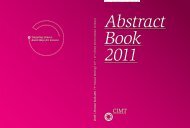Abstract Book 2010 - CIMT Annual Meeting
Abstract Book 2010 - CIMT Annual Meeting
Abstract Book 2010 - CIMT Annual Meeting
Create successful ePaper yourself
Turn your PDF publications into a flip-book with our unique Google optimized e-Paper software.
019 Buhl | Therapeutic vaccination<br />
Cryopreservation of high-concentrated peripheral blood mononuclear<br />
cells by controlled-rate freezer results in higher cell<br />
yields for dendritic cell-based immunotherapy<br />
Timo Buhl 1 , Anke Schardt 1 , Tobias Legler 2 , Michael P. Schön 1 , Holger A. Hänßle 1<br />
1 Department of Dermatology and<br />
2 Department of Transfusion Medicine of Georg August University, Göttingen, Germany<br />
Cryopreservation of immature or mature dendritic<br />
cells (DC) has been described as a suitable method<br />
to achieve large numbers of DC for immunotherapeutic<br />
trials against cancer. Recently it was shown<br />
that cryopreservation of peripheral blood mononuclear<br />
cells (PBMC) with subsequent differentiation<br />
into DC is superior compared to cryopreservation<br />
of immature or mature DC in terms of resulting DC<br />
quantity and immuno-stimulating capacity. The<br />
aim of our study was to establish an optimized<br />
protocol for the cryopreservation of highly-concentrated<br />
PBMC for DC-based immunotherapy. Cryopreserved<br />
cell preparations were analyzed regarding<br />
recovery, viability, phenotype, and functional<br />
properties. Results were compared to fresh DC<br />
generated instantly from the same donor. In contrast<br />
to PBMC frozen by standard isopropyl alcohol<br />
freezing containers, PBMC cryopreservation in an<br />
automated controlled-rate freezer (CRF) resulted<br />
in significantly higher cell yields of immature and<br />
mature DC after thawing and subsequent differentiation<br />
to DC. The CRF is connected to liquid nitrogen,<br />
allowing the freezing program to exactly<br />
control and adjust the temperature of the freezing<br />
chamber. Therefore, the crystallization heat at the<br />
freezing point of the sample can be compensated<br />
by a sharp temperature decrease in the freezing<br />
chamber. Immature DC yields and total protein<br />
content after using CRF were comparable to freshly<br />
generated DC and exceeded results of standard isopropyl<br />
alcohol freezing by approximately 50%. DC<br />
generated after both freezing protocols of PBMC revealed<br />
no relevant phenotypic or functional differences.<br />
Our analyses included phenotypic markers,<br />
allogenic T cell stimulatory assays, viability tests<br />
and microarray cytokine profiles. The latter showed<br />
that few cytokines were differently secreted during<br />
DC maturation depending on the method of cryopreservation.<br />
The majority of cytokine levels was<br />
not altered in correlation with the method of cryopreservation.<br />
In summary, automated controlled<br />
rate freezing of PBMC represents a much improved<br />
freezing method capable of increasing DC yields for<br />
cancer immunotherapy.<br />
55



